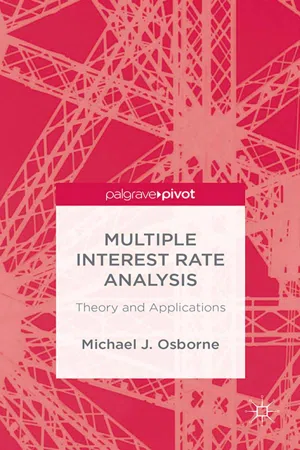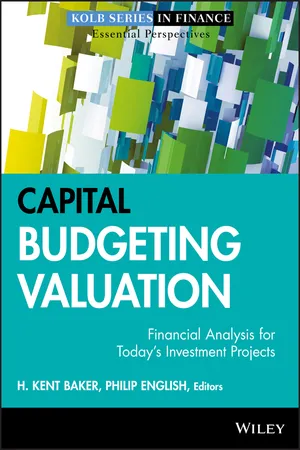Business
IRR Pitfalls
IRR, or internal rate of return, can be a valuable tool for evaluating investment opportunities, but it has some potential pitfalls. These include the assumption of reinvestment at the IRR, which may not reflect real-world conditions, and the potential for multiple IRRs in complex cash flow patterns. Additionally, IRR may not account for the scale of investments or the timing of cash flows.
Written by Perlego with AI-assistance
Related key terms
Related key terms
1 of 4
Related key terms
1 of 3
3 Key excerpts on "IRR Pitfalls"
- eBook - ePub
Multiple Interest Rate Analysis
Theory and Applications
- M. Osborne(Author)
- 2014(Publication Date)
- Palgrave Pivot(Publisher)
(2004). Many studies of capital budgeting practice are published every year containing similar results for various countries. In the context of IRR as a performance measure for private equity firms, hedge funds, and venture capitalists see the works by Phalippou (2008), Phalippou and Gottschalg (2009), Dichev and Yu (2011), and Achleitner et al. (2013). In the context of public-private partnerships (PPPs), the UK government counsels caution about the use of IRR to appraise public investment projects (HM Treasury 2004), yet the practice continues with unfortunate consequences for education and health care (see, for example, Cuthbert and Cuthbert, 2012). Why do so many practitioners fail to heed academic advice? One possible reason is that they do not find the advice persuasive. This chapter employs multiple-interest-rate analysis to demonstrate that the IRR Pitfalls do not provide convincing arguments. A new dual expression for NPV is derived supporting the arguments begun in Osborne (2010a) that the second and third pitfalls are inadequate, and therefore finance textbooks describing the pitfalls should be revised. The analysis goes on to introduce a quantum of value as an analytical device enabling the new dual expression to demonstrate why the fourth IRR pitfall concerning non-flat yield curves is also inadequate. Finally, a more convincing reason than the IRR Pitfalls to prefer NPV is provided by the new dual expression itself: a project’s NPV possesses meaningful information additional to that possessed by its IRR. The chapter concludes with two annexes. The first annex contains numerical examples of the new dual expression coping with various types of unconventional cash flows. The second annex contains a case study of multiple-interest-rate analysis applied to public-private partnerships (PPP) - eBook - ePub
Finance
Capital Markets, Financial Management, and Investment Management
- Frank J. Fabozzi, Pamela Peterson Drake(Authors)
- 2009(Publication Date)
- Wiley(Publisher)
The index value is greater than one, which means that the investment produces more in terms of benefits than costs. An advantage of using the profitability index is that it translates the dollar amount of NPV into an indexed value, providing a measure of the benefit per dollar investment. This is helpful in ranking projects in cases in which the capital budget is limited.The decision rule for the profitability index depends on the PI relative to 1.0, which meansINTERNAL RATE OF RETURN
Suppose an investment opportunity requires an initial investment of $1 million and has expected cash inflows of $0.6 million after one year and another $0.6 million after two years. This opportunity is shown in Figure 14.3 using a time line.The return on this investment (denoted by internal rate of return or IRR, in the next equation) is the discount rate that causes the present values of the $0.6 million cash inflows to equal the present value of the $1 million cash outflow, calculated asAnother way to look at this is to consider the investment’s cash flows discounted at the IRR of 10%. The NPV of this project if the discount rate is 13.0662% (the IRR in this example), is zero:An investment’s internal rate of return is the discount rate that makes the present value of all expected future cash flows equal to zero. We can represent the IRR as the rate that solves Going back to Project X, the IRR for this project is the discount rate that solves Using a calculator or a computer, we get the answer of 10.172% per year.FIGURE 14.3Timeline of Investment OpportunityLooking back at the investment profiles of Projects X and Y, each profile crosses the horizontal axis (where NPV = 0) at the discount rate that corresponds to the investment’s IRR. This is no coincidence: by definition, the IRR is the discount rate that causes the project’s NPV to equal zero.The IRR is a yield—what is earned, on average, per year. How do you use it to decide which investment, if any, to choose? Let’s revisit Projects X and Y and the IRRs we just calculated for each. If, for similar risk investments, owners earn 10% per year, then both Projects X and Y are attractive. They both yield more than the rate owners require for the level of risk of these two investments: - eBook - ePub
Capital Budgeting Valuation
Financial Analysis for Today's Investment Projects
- H. Kent Baker, Philip English, H. Kent Baker, Philip English(Authors)
- 2011(Publication Date)
- Wiley(Publisher)
The dominance of NPV as a project evaluation method among academics does not appear to be shared by practitioners who often prefer to use IRR and the seemingly inferior PB measure. The use of PB appears to be a combination of focus on short-term liquidity needs (with or without an agency issue) and a cost-benefit analysis relative to project evaluation. In other words, safe or lesser valued projects do not warrant extensive analysis and are not good candidates for a NPV analysis.The popularity of IRR is more puzzling in that it is an imprecise rate of return metric. For instance, having an IRR of 13 percent versus an appropriate risk-adjusted return of 10 percent does not imply a gain of three percentage points. Consequently, the interpretation that people often assign to the IRR is incorrect because the percentage point gain can only be obtained if intermediate cash flows can appreciate at the IRR throughout the project's life. This “problem” became known as the “reinvestment problem,” which led to much research to better define the issue and to potentially mitigate the problem by calculating MIRR.MIRR is consistent with NPV because the NPV calculation is actually within the MIRR calculation. This equivalence can be seen by evaluating the MIRR calculation in terms of the PI, which is an NPV calculation in a ratio format. PI is generally not as useful as the NPV calculation, but PI does have some benefits when evaluating acceptable projects under a capital constraint.In general, all of these metrics are related in some fashion. IRR is the discount rate that sets NPV to zero, PI to one, and DPB and PBL to the duration of the project. An NPV > 0 implies that the project life is greater than PB, DPB, and PBL, PI > 1, and MIRR > cost of capital (or a hurdle rate). An NPV < 0 implies that the project life is less than DPB and PBL, PI < 1, and MIRR < cost of capital (or a hurdle rate). Being able to see these relationships allows the decision maker to use more than one metric, convert a given metric into another, and understand the biases of each metric. Ultimately, the decision maker should realize that these project evaluation techniques are simply tools to help in the decision-making process. All of the considerations necessary for making the decision are not contained within any one of these metrics alone or combined.
Index pages curate the most relevant extracts from our library of academic textbooks. They’ve been created using an in-house natural language model (NLM), each adding context and meaning to key research topics.
Explore more topic indexes
Explore more topic indexes
1 of 6
Explore more topic indexes
1 of 4


